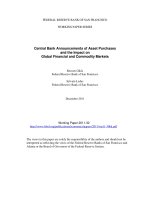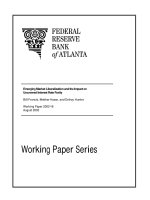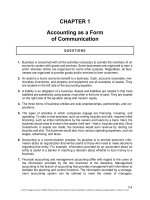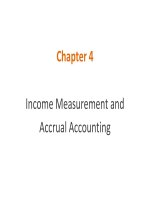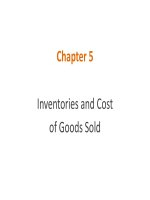Financial accounting the impact on decision makers 9e chapter 5
Bạn đang xem bản rút gọn của tài liệu. Xem và tải ngay bản đầy đủ của tài liệu tại đây (3.7 MB, 64 trang )
Chapter 5
Inventories and Cost
of Goods Sold
Inventory Types
Finished inventory: held by retailers and wholesalers
Merchandise inventory
Materials inventory: held by manufacturers
Raw materials
Work-in-progress
Finished goods
LO 1
Types of Manufacturing Costs
Direct materials: also called raw materials
Ingredients used in making a product
Direct labor: amounts paid to workers to manufacture
the product
Manufacturing overheads: all other costs that are
related to the manufacturing process but cannot be
directly matched to specific units of output
Example: depreciation of building and salary of
supervisor
Three Forms of Inventory
Direct materials
The inventory of a manufacturer before the addition
of any direct labor or manufacturing overhead
Work in process
Cost of unfinished products in a manufacturing
company
Finished goods
A manufacturer’s inventory that is complete and
ready for sale
Exhibit 5.1 Relationships between Types of
Businesses and Inventory Costs
Account for Sales of Merchandise
Sales revenue: representation of the inflow of assets,
either cash or accounts receivable, from the sale of a
product during the period
Sales Return and
Net Sales = Sales −
− Sales Discount
Allowances
Gross Profit = Net Sales − Cost of Goods Sold
LO 2
Exhibit 5.3—Net Sales Section of
the Income Statement
Sales Returns and Allowances
Sales returns and allowances: contra-revenue account
used to record refunds to customers and reductions of
their accounts
Sales discounts: contra-revenue account used to
record discounts given to customers for early payment
of their accounts
Credit terms: firm’s policy for granting credit
Example: n/30; Net, 10 EOM; 1/10, n/30
Credit Terms and Sales Discounts
Credit terms: firm’s policy for granting credit
n/30: the
net amount of the selling price is due
within 30 days of the date of the invoice
Net, 10 EOM: the net amount is due anytime within
ten days after the end of the month
1/10, n/30: the customer can deduct 1% from the
selling price if the bill is paid within ten days
Sales discounts: contra-revenue account used to
record discounts given to customers for early
payment of their accounts
Cost of Goods Sold
Recognition of cost of goods sold as an expense is an
excellent example of matching principle
Sales revenue: inflow of assets, cash or accounts
receivable
Cost of goods sold: outflow of asset, inventory
Cost of goods available for sale
Beginning inventory + Cost of goods purchased
Cost of goods sold
Cost of goods available for sale − Ending inventory
LO 3
Exhibit 5.4—Cost of Goods Sold
Section of the Income Statement
Exhibit 5.5—Cost of Goods Sold
Model
Inventory Systems: Perpetual and
Periodic
Example 5.3—Recording Cost of Goods
Sold in a Perpetual System
Daisy’s sells a pair of running shoes that costs $70. In
addition to the entry to record the sale, Daisy’s would
also record an adjustment as follows:
Exhibit 5.6—Cost of Goods
Purchased
Example 5.4—Recording Purchase
in a Periodic System
Daisy’s buys shoes from Nike at a cost of $4,000. The
effect is to increase liabilities and increase cost of
goods sold, which is an expense
Example 5.5—Recording Purchase
Returns in a Periodic System
Daisy’s returns $850 of merchandise to Nike for credit
on Daisy’s account. The return decreases both
liabilities and purchases. Because a return reduces
purchases, it has the effect of reducing expenses and
increasing net income and stockholders’ equity
Example 5.6—Recording Purchase
Discounts in a Periodic System
On March 13,there is a purchase of merchandise for
$500, with credit terms of 1/10, n/30
Example 5.6—Recording Purchase
Discounts in a Periodic System (continued)
Purchase Discounts
A contra-purchases account used to record reductions
in purchase price for early payment to a supplier
Shipping Terms and Transportation
Costs
Cost principle: All costs necessary to prepare an asset
for its intended use should be included in its cost
FOB destination point: seller incurs the transportation
costs
FOB shipping point: buyer incurs the transportation
costs
FOB stands for ‘‘free on board’’
Example 5.7—Recording
Transportation-In in a Periodic System
Assume that on delivery of a shipment of goods,
Daisy’s pays an invoice for $300 from Rocky
Mountain Railroad. The terms of shipment are
FOB shipping point
Example 5.8—Determining the Effect of
Shipping Terms on Purchases and Sales
The Gross Profit Ratio
Important measure of profitability
Indicates a company’s ability to cover operating
expenses and earn a profit
Relationship between gross profit and net sales—
measured by the gross profit ratio—one of the most
important measures to assess the performance of a
company
Gross Profit Ratio =
Gross Profit
Net Sales
LO 4
The Ratio Analysis Model
1.
2.
3.
4.
5.
How much of the sales revenue is used for the cost
of the products, and thus, how much remains to
cover other expenses and to earn net income?
Gather the information about net sales and cost of
goods sold
Calculate the gross profit ratio
Compare the ratio with prior years and with
competitors
Interpret the ratios—showing increase or decrease
